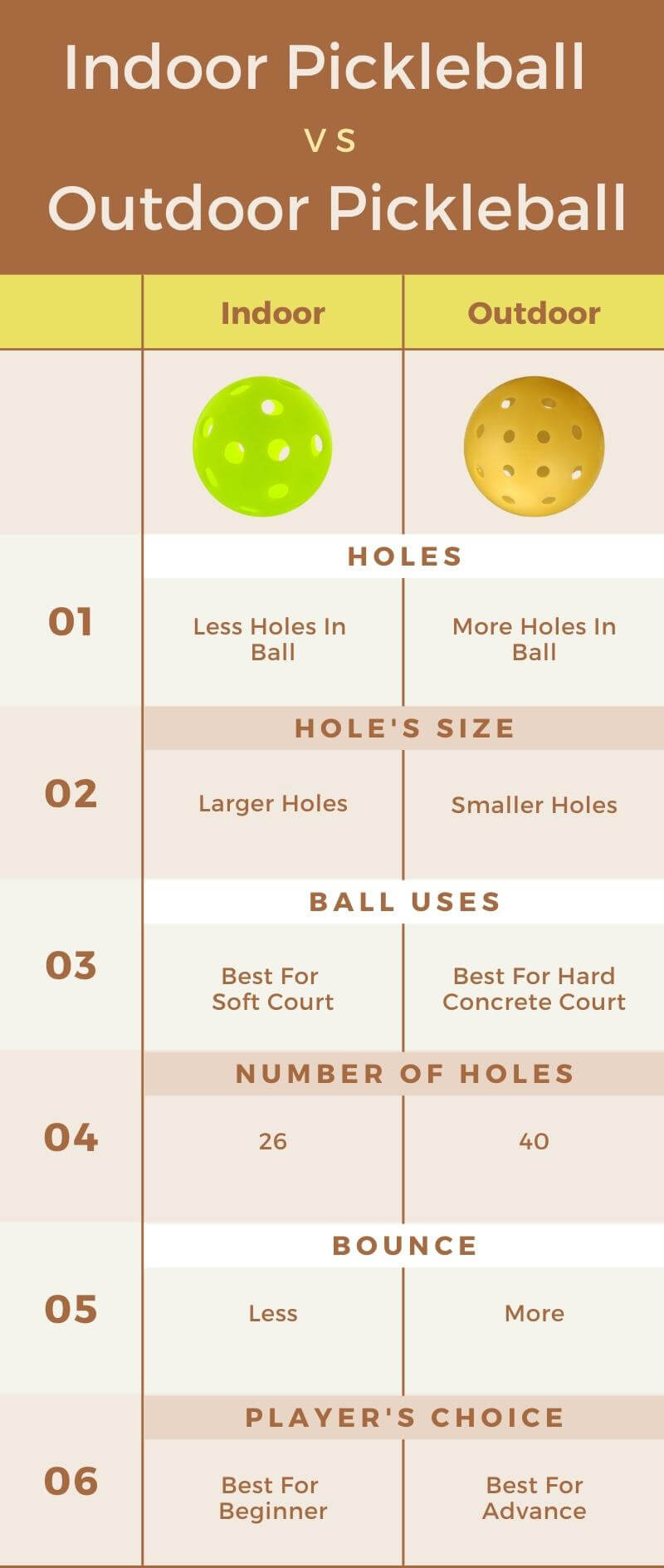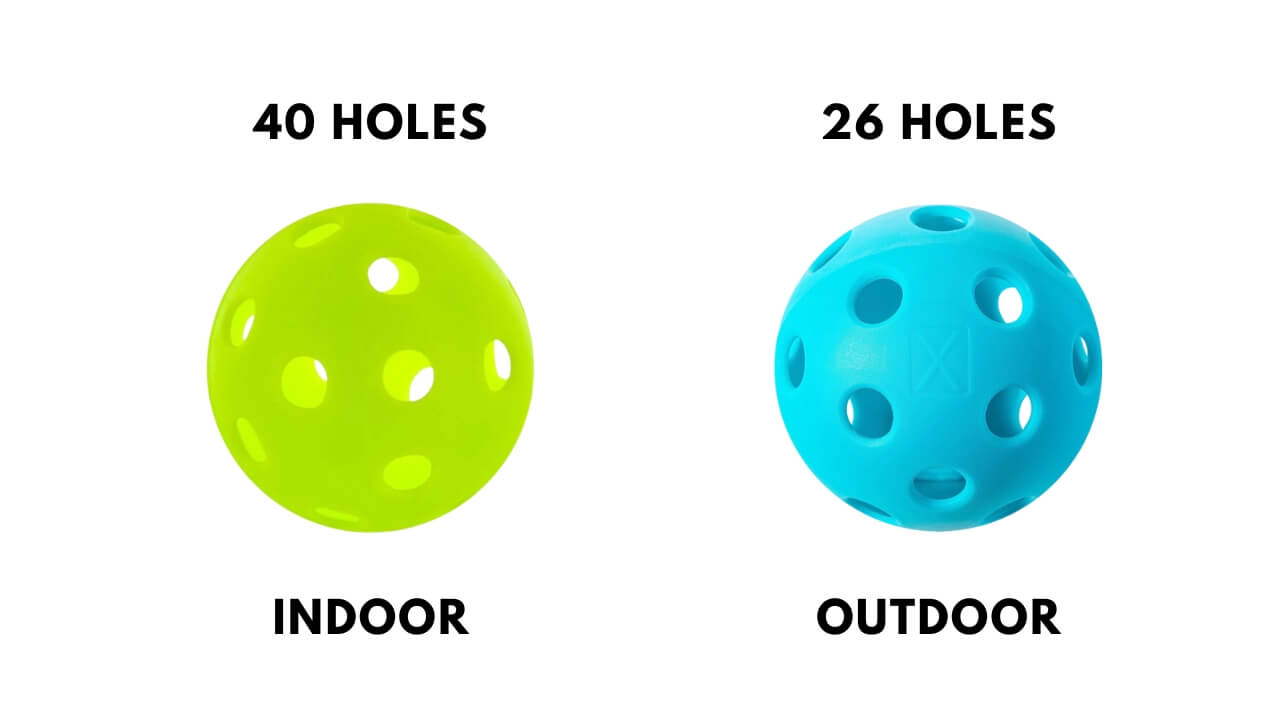This guide does a side-by-side comparison to tell you what the difference is between indoor and outdoor pickleball balls.
What is The Difference Between Indoor And Outdoor Pickleball Ball? | Indoor Vs Outdoor Pickleballs
The most obvious difference between indoor and outdoor Pickleball balls is that they are designed for different pickleball courts. For instance, indoor balls are designed for enclosed venues, where players can enjoy a slower spin and a casual game. Indoor pickleball balls are preferred by professional players who want to enjoy speed, momentum, and thrill in outdoor conditions, where they are constantly bothered by extreme wind and weather interference. You can use the same pickleball paddle on both pickleball balls.

But the question is, which one is better for you? Well, the answer is not simple, and multiple factors count into it, the difference between these balls being the foremost important. According to USAPA official pickleball rules, pickleball ball size should be between 2.874 inches (7.30cm) to 2.972 inches and circumference between 9.029 inches (22.93cm) and 9.337 inches (23.72cm).
Here are some common differences you will find between indoor and outdoor Pickleball balls, so dive right in to know more.
1. Holes
The first and foremost difference you will find between these types of Pickleball balls is the number of holes. Outdoor Pickleballs have approximately 40 holes, as compared to indoor balls, which only have around 26 holes. The reason behind this is to cancel the external factors on the pickleball court to make them effective for specific conditions.
Now, when we talk about outdoor courts, they have harsh weather conditions and intense wind, which makes the ball move at a faster speed. And more holes mean strong, thick construction and resistance to wind, so the ball is able to move in a straight trajectory. This also interferes with the aerodynamics of the ball for better bounce.
In contrast, speaking of indoor pickleball courts have fewer holes, and each hole has a uniform gap between them. Not only this, all the holes are of the same size to create more negative space and make the ball travel at a slower pace. That said, there are also hybrid balls used in Pickleball with around 32 holes.
Apart from the number of holes, the diameter of a pickleball also plays an important role in the construction. Though there are no specific criteria, indoor balls generally come with a wide hole diameter, which is around 0.43 inches. On the contrary, outdoor balls tend to have pickleball ball hole sizes of around 0.282 inches in diameter for better maneuverability.
2. Weight
The next thing difference between indoor and outdoor Pickleball balls is their weight. There are no specific rules for pickleball ball weight, but it should be between 0.78 ounces (22.1g) and 0.935 ounces (26.5g). In a nutshell, outdoor balls tend to be a bit heavier than indoor ones. The logic behind them being heavier and bulkier is that these balls are designed to survive the outdoor weather and a fast speed.
Another reason for the outdoor balls being heavier is the more holes. Because they generally have around 40 holes and a wider diameter that covers less surface area and the negative space around the holes. Hence, this adds to the weight.
Similarly, the outdoor balls are bulkier and thicker because they are designed to follow a straight path despite the fast wind. This complements the conditions on the court and makes them resistant to weather interference. That said, we cannot undermine the pickleball ball material construction in this aspect, as it also plays a vital role in determining the weight.
On the contrary, indoor balls have fewer holes and more negative spaces, making them thinner and lighter in weight. This is why you will find it easy to achieve a slower pace on the indoor court. Likewise, they are made up of low-density plastic that cuts down the weight and makes them suitable for intended use.
3. The Hardness Of The Balls
Almost all Pickleball balls are made up of plastic, which is why they are hard and strong. That said, you cannot tell about the level of hardness just by seeing and touching it. For this purpose, technicians use the durometer, which has a hardness measurement scale, making it easy for you to choose the right type of ball for the right court.
When it comes to measuring hardness, it is typically divided into four classes of plastic, each having a certain rating. This includes,
- LDPE – Low-Density Polyethylene: 40-50 D
- HDPE – High-Density Polyethylene: 60-70 D
- PP – Polypropylene: 70-83 D
- PET – Polyethylene Terephthalate: 85-95 D
When we compare both types of balls, it is evident that outdoor Pickleball balls tend to be a little harder than indoor ones, and most of it comes down to the court. Because we need a fast pace in outdoor conditions, these balls use harder high polyethylene plastic. This is also the reason why these balls are thicker and heavier.
On the contrary, indoor Pickleball balls are made up of low-density polyethylene plastic, which is a little softer and allows you to achieve a slower pace. Typically, they have a general 40-50 Shore D rating, which makes it low to medium hard. Hence, you will find them thinner and lighter than usual.
Durability And Material Construction
Likewise, another difference you will find between the two types of balls is durability. Most people think that Pickleball balls are designed to last you forever, which is not quite true. After some time, even a really good ball will lose its shape and hardness despite the court.
Overall, it comes down to the construction material used for the ball. And the rule of thumb is that the more density plastic has, the more durable and harder the ball will be. Therefore, it wouldn’t be wrong to say that outdoor balls tend to be a lot more durable than indoor ones.
Though both types of balls are made up of plastic, the nature of plastic differs tremendously. For instance, outdoor pickleball balls are made up of high-density polyethylene plastic, whereas companies use low to medium-density polyethylene plastic (which is a lot softer).
Overall, the TPE harder plastic used in outdoor balls is resistant to cracks, making them efficient in surviving harsh conditions. That said, hard plastic other than TPE is prone to cracking, which makes it a little tricky to find the right match. When it comes to the softer plastic, they usually get damaged by the continuous bounce on the court.
Which Type Of Pickleball Ball Is Best?
The right type of ball can take your game up to a whole new level. There are a number of factors that count when it comes to finding the right type of Pickleball balls. Following are some of the things you must consider before choosing a Pickleball ball for yourself.
- Each court has a different type of ball used in them. Hence, you need to choose a ball that is designed specifically for that court.
- A player’s skill rating also makes a huge difference in your decision to choose a ball. For instance, beginners usually like playing slow swings, which is only possible with indoor Pickleballs. And if you are an experienced player who likes speed and momentum on the field, the outdoor ball may work best for you.
- The external conditions of the court further need to be considered when it comes to choosing the right Pickleball. If you are most likely to play in outdoor conditions, it is important to get a ball that can resist extreme wind. In this case, the more holes are always better.
Frequently Asked Questions
What Type Of Balls Do You Use For Outdoor Pickleball Games?
Outdoor balls are preferred by professional players who are fond of enjoying outdoor Pickleball games. This is because these balls are hard, thicker, and have more holes. This helps players with a perfect balance and momentum, not to mention resist weather interference ideally.
What Do Beginner Pickleball Players Use?
Beginners usually prefer using indoor Pickleball balls because they are easy to use and provide you with a slower swing. These balls are soft and lighter in weight, so players don’t have to put in extra effort to get used to them.
Do Pickleball Balls Crack In The Cold?
Yes, Pickleball balls are prone to cracks, especially when they are in cold conditions. This is because they are made up of plastic that easily gets affected by external factors on the court, cold being one of them.
Do Outdoor Pickleball Balls Have Large Or Small Holes?
Typically, outdoor Pickleball balls have around 40 holes with a smaller (0.282 inches) diameter. These holes have an equal size with a uniform distribution all over the ball, which makes them thicker, heavier, and rugged against extreme weather conditions.
How Many Holes Does An Indoor Pickleball Balls Have?
Indoor Pickleball balls have approximately 26 holes with a wider diameter. Like outdoor Pickleball balls, these holes have equal sizes with a uniform distribution.
What Does A Pickleball Look Like?
A pickleball ball looks like a large perforated ball with round holes and is heavier than a wiffle ball. They produce less bounce than tennis balls. A pickleball is present in different colors and weights for indoor and outdoor courts. Number of holes also differs both for indoor and outdoor courts.
Can You Use Outdoor Pickleballs Indoors?
Yes, you can use outdoor pickleballs for indoor courts, but it is not advisable. The reason is that outdoor pickleballs are heavier, designed for rough court surfaces, more durable, and can resist wind. On the other hand, indoor pickleballs are lightweight, designed for smooth court surfaces, and produce less bounce. It will not provide the desired results and also will not be a good experience for any pickleball player.
What Is A Pickleball Made Of?
Pickleballs are crafted from polymer, resin, and hard plastic material. The surface of the pickleball ball usually has holes, which helps in reducing air friction during play.
How Long Do Pickleball Balls Last?
The lifespan of pickleball balls depends upon various factors including quality, frequency of use, playing conditions, and storage methods. Typically, the pickleball balls can last from a few games to several months under normal conditions.
Final Thoughts
New players need to know what makes the indoor and outdoor balls different in a Pickleball game. This is because it helps you upgrade your skills and take your game to a whole new level. And I expect that now, you have a clear understanding of the differences between indoor and outdoor Pickleball balls.
Other Related Posts:
- How To Play Pickleball?
- Difference Between Portable & Permanent Pickleball Net
- Paddle Tennis Vs Pickleball
- Best Pickleball Paddles For Women
- How To Pick A Pickleball Paddle?

I, Jeena Noven, am a renowned pickleball expert and author with over 10 years of experience playing and coaching the sport. My passion and extensive knowledge of pickleball has made me a leading authority in the game, particularly in the field of footwear. I have written countless articles for https://pickleballcard.com/, a website dedicated to pickleball, sharing my insights and expertise on the best shoes for the sport. Through personal testing and reviewing countless different brands and styles, I have developed a deep understanding of the technical aspects of shoe design that make them suitable for the demands of pickleball. In my articles, I provide valuable information for both beginner and advanced players, covering everything from the basics of shoe fit and support, to advanced tips for maximizing performance on the court. As a dedicated pickleball player and expert in footwear, I am a valuable resource for players of all levels. My articles are not only informative but also engaging, making them a must-read for anyone looking to improve their pickleball game. I am constantly researching new products and trends in the industry and my readers can always count on me to provide the most up-to-date and accurate information on the best pickleball shoes available.

Leave a Reply